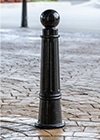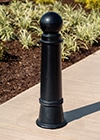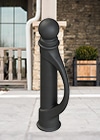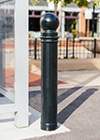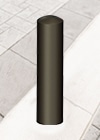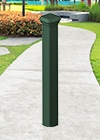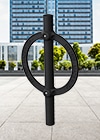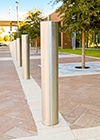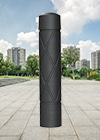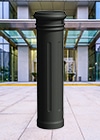Bollards are arguably the most flexible fixture of any hardscape.
They can stand out as a showpiece, or blend in entirely. They protect people and structures in applications ranging from courthouses and military bases to small-town storefronts and public parks.
In other words, you can put them practically anywhere, assign them almost any function and — if you choose the right manufacturer — give them almost any aesthetic quality so that they look like they belong.

So, you’ve got options. As far as types of bollards goes, maybe even too many.
And the last thing landscape architects and specifiers need is a confusing process that takes too long.
Our objective with this guide is to provide the information you need to specify bollards that perfectly match your project’s requirements — and fast.
It covers:
- How your project parameters inform bollard specification
- Understanding bollard materials and installation specifications
- A survey of crash ratings and standards authorities
- What to know about bollard finish options, including paint and other coatings
- A quick primer on removable bollards for maximum flexibility
- Factors influencing how much bollards cost
- Bollard maintenance and product warranties
- How to choose the right bollards manufacturer
Click any of the bullet points above to jump directly to that discussion.
Project parameters drive bollard specification decisions
Above, we hinted that bollard specification is quite widely variable because there are so many ways these fixtures are used.
To break it down most simply, bollards are specified for three main functions.
Specifying fixed decorative bollards
Architects specify decorative bollards because they are an effective way to define or divide spaces in a landscape without creating solid, coarse barriers like walls or fences that hamper access and diminish visual appeal.
Consider the perimeter of a fountain in the town square or the bicycle path meandering through a park. Bollards are common in these spaces because they add aesthetic appeal while preserving people’s ability to move freely.
Your objective, then, is choosing bollards that appear to belong. Available color schemes, design variety and other customizations will be your overriding concerns. What the bollards are made of, and how they are installed, are of secondary importance to preserving the overall aesthetic of a space.

And though safety is not their primary function, decorative fixtures can keep people and landscapes safe due to the visual friction they introduce in someone’s field of view. Drivers who see barriers that separate one space from another — even that barrier takes the form of a row of bicycle bollards — are more likely to avoid them.
Cost is covered in detail later, but purely decorative bollards are usually cheaper to buy and much cheaper to install because they do not need to meet any impact resistance criteria.
Specifying fixed protective bollards
These are fixtures specifically rated to withstand vehicular impacts of varying severity.
On one end of the ratings spectrum, protective bollards must be able to stop vehicles weighing 15,000 pounds traveling at 30 miles per hour. These are commonly specified to separate pedestrian and vehicular rights of way on local streets but certainly not along arterial roads or highways.
On the opposite end, bollards meeting the highest standard of protection are commonly found around sensitive buildings like federal courthouses, military installations or diplomatic posts. They must be able to stop a vehicle weighing 15,000 pounds traveling at 60 miles per hour. As the threat of terrorism increased worldwide, these hyper-protective bollards have become a key component of the protection of any military or government installation, including American sites subject to antiterrorism/force protection (AT/FP) benchmarks.
View the U.S. Army Corps of Engineers summary of AT/FP requirements here.
Obviously, these fixtures are more expensive to buy and involve a much more intensive (and therefore pricey) installation.
Some projects blend aesthetics and protection
When that’s the case, a specifier must be able to keep both the aesthetic and protective functions top-of-mind at once.
It is comparatively easy to define the degree of protection that bollards must provide. As long as you understand the installation site, its immediate surroundings and any other previously stated project specifications, you have what you need.
Similarly, aesthetic objectives are also rather easily defined. By the time it is up to you to specify fixtures, the project owner or architect has likely given instruction on what they want to see.

Here’s the hard part:
Locating a provider who can build bollards that look the way the owner wants them to look while also meeting crash protection requirements. Far fewer providers combine the engineering know-how and manufacturing equipment to make custom bollards that meet these complex hybrid requirements.
Which is best for you?
All this is to say that as a specifier, it’s not just that you’re responsible for choosing bollards. You must choose the right bollards.
That means you must balance the competing concerns of a project:
- Meeting protective requirements, if any
- Assuring aesthetic appeal
- Securing timely delivery
- Specifying correct installation
- Keeping an eye on cost
Bollards installation considerations by type: decorative vs. safety bollards
Specifying bollards is a linear process: You won’t know whether a decorative, protective or hybrid fixture is ideal without first understanding the overall project parameters and the environment in which the work will occur.
Similarly, the way a bollard is made and how it should be installed is only clear once you know whether you must specify for protective, decorative or hybrid purposes.
Decorative bollards materials and installation
With no crash ratings to worry about, purely decorative bollards can be made of anything. Specifiers’ only limitation will be cost.
Cast iron is a good choice because it is readily available, aesthetically pleasing and sturdy when properly coated and maintained. Timber beams, while quite cheap, are still a great choice in select settings. Heavy plastics are another option, though not a good one in our opinion. While they are cheap and easily customizable, they do not look the best and are frightfully easy to damage.
Other materials like stainless steel or concrete can be specified for decorative fixtures, but:
- The low cost of concrete is outweighed by the extreme difficulty in getting it to look nice
- Stainless steel is overly expensive; it looks beautiful but should only be specified for decorative use if the owner doesn’t mind paying a premium

Decorative bollard installation specifications are fairly rudimentary. If the fixtures will be installed on an existing concrete surface, one needs only to drill holes and bolt them down. For decorative bollards that will be placed somewhere away from an existing concrete surface, a modest concrete footing can be poured. Only in that latter case should hiring a concrete contractor for installation be necessary, provided they have the proper tools and know-how.
Protective bollards materials and installation
Protective bollards are usually made of concrete, steel or cast iron, and in many cases (such as when aesthetics and protection must coexist) you will encounter steel pipe bollards that fit inside a cast iron or plastic decorative sleeve.
Concrete bollard specification is the rarest. Pound for pound, concrete is cheaper than steel. But it takes much more concrete to offer an identical degree of protection as an anchored steel pipe does. As such, concrete bollards serving protective purposes are usually very large and bulky. And even if protection supersedes aesthetics, no one likes an eyesore.
That’s why steel pipe bollard specification (or steel pipe inside a cast iron sleeve) is far more common. When properly anchored, they offer maximum protection in a lower profile. Depending on their protective requirements, they may be made with double walls or anchored in enhanced steel foundations.
A moment ago, we used the phrase “anchored steel pipe.” This may lead to a question we are frequently asked: How deep should bollards be installed?
How deep should bollards be installed?
A traffic bollard’s required crash rating ultimately determines its installation specifications. When maximum protection is needed, bollards will need to be anchored to concrete footings that are sunk as much as four feet below grade. Generally, as protective requirements are reduced, the shallower a bollard’s footing can be poured.
(For some projects, digging downward is not an option. Consider specifying K4 shallow foundation mounting instead. This entails pouring a shallower but wider foundation instead of a narrow but deep one.)
While we’re on the topic of questions, here’s another: How far apart should bollards be?
How far apart should bollards be?
In protective or hybrid applications, station the fixtures no more than four or five feet apart. If aesthetics are all that matter, space them however you please. For crash-rated bollards, it is best to leave installation to the professionals. Engage a local concrete contractor. It’s no knock on them, but ordinary facility or municipal maintenance personnel do not have the needed equipment or skillset for these more complex installations.

Specifying bollards for both protection and aesthetic appeal
This is a challenge. As we observed above, you will need to balance the project’s protective requirements against an owner’s or architect’s aesthetic guidance.
Your best bet is to locate a manufacturer who has demonstrated they can deliver on both accounts and pick their brain in case their past experience applies nicely to your present project.
The engineers at BollardsUSA are happy to help. It’s easy to get a hold of them, too. Fill out the form here if you want, but you can also just call 1-502-554-1178. A real human in Kentucky will answer the phone.
We also very clearly provide specs on each of our products online — just use our easy selector tool in the products section of our site.
Crash-rated bollard rules, regulations and standards: A quick survey of who’s in charge
There’s quite a patchwork of agencies and authorities that define rules and standards for crash-rated bollards.
ASTM publishes the F3016 and F2656 standards. The former covers low-speed impacts up to 30 miles per hour while the latter covers higher-speed impacts up to 60 miles per hour.
In addition to potentially meeting the ASTM standards above, the Occupational Safety and Health Administration (OSHA) states that permanent bollards in regulated work sites must be painted a canary yellow.

Elsewhere, the U.S. Department of State published what used to be known as “K-ratings,” which defined how well the barriers outside their facilities needed to protect against vehicle impact. But in 2009, State conformed its requirements to those published by ASTM.
While the International Building Code (IBC) does not define crash ratings, they do offer recommendations regarding the dimensions and placement of bollards as they relate to building ingress, egress and service areas.
And then there’s your local municipality. A question commonly asked at the outset of any project is: Do I need planning permission to install bollards?
Do I need planning permission to install bollards?
The long answer is that it depends:
If your work is part of a project that already was subject to planning approval, that approval probably covers the bollard installation.
If you’re installing bollards adjacent to federal or state highways and the project is partially funded or subsidized by the fed or your state, regulators will need to verify the bollards meet crash ratings. In fact, the funding is often contingent on meeting those ratings.
If you’re part of a private entity specifying bollards for installation on property you own, you probably do not need planning permission so long as you’re simply bolting bollards to concrete at grade. But if you’re digging underground, you should assume that some third party, even if it is not the municipality, will need to sign off.
The short answer is, call your municipality to find out. Everyone’s rules are bound to vary. And speaking of rules…
When are bollards required?
A simple answer might be that bollards are required in any setting where pedestrians or structures must be protected against other traffic.
But it’s not that straightforward: Whether the requirement comes from a city council, state legislature or federal agency, it won’t specifically state that “bollards” must be installed.
Instead, it’ll use the word “barrier” or something similarly vague. Barriers are commonly required to control access to city, state and federal government buildings as well as military and diplomatic installations.

Bollards can be considered barriers if they’re appropriately spaced, but a brick wall is a barrier, too. So is a fence or a jersey barrier or even a concrete flower pot.
So, when are bollards required?
Bollards are required when municipal authorities or architects specify that they are the appropriate barrier for the project. Many factors inform this decision, including city planning guidelines, traffic control requirements, pedestrian safety concerns and, as always, aesthetic appeal.
If you’re in doubt, get in touch with any regulating authority involved on the project.
Bollard paint specification: A quick word on protective coatings
Any bollard installed out in the elements will degrade over time, so protection is crucial.
So, should you paint bollards?
If they’re only made of concrete, yes, you should paint them. Not all coatings are created equal, so be sure you’re using one specifically made for concrete adhesion.
As for cast iron, you have a couple options. Coating cast iron with paint is actually a bad idea because paint degrades when exposed to the elements. That degradation may lead to chipping or peeling which increases the risk of corrosion of the iron underneath.
If you want a smooth, even and attractive finish, powder coating is ideal for cast iron. Powder coating involves the application of organic powder by electrostatic attraction to metal creating a smooth, durable surface finish. In addition to superior longevity and corrosion resistance, powder coating is a more efficient and environmentally friendly coating process than traditional wet paint. Any overspray with powder coating is reclaimed and re-used, and there is no use of environmentally harmful materials since chemical solvents and VOCs are not required.

It’s also worth noting that cast iron does not require a coating of any kind to effectively resist corrosion or weathering. In fact, bare cast iron is among the most corrosion resistant building materials available. As cast iron is exposed to normal environmental conditions, it will oxidize, or rust. The oxidation of carbon-based metals like cast iron will transition from orange to dark brown colors over time, depending on age and exposure. After a period of time the cast iron develops an oxide layer, or patina, on its surface which acts as a highly durable, visually appealing and 100% maintenance-free finish.
One could sidestep coating requirements by specifying stainless steel bollards, but be sure to weigh the pros and cons. It’s a comparatively expensive option but its corrosion resistance is very high. However, they don’t always look great in settings with a more traditional aesthetic appeal. In that case, opt for powder-coated steel or cast iron. Browse our products to see a wide range of bollard finishes as well as other options, including materials, dimensions, mounts and customizations.
Consider specifying removable bollards for maximum flexibility
So far, we’ve confined this discussion to fixed bollards that, once installed, stay where they are for life.
But some project requirements are unique enough to warrant fixtures that offer suitable pedestrian protection or space definition one day and then disappear the next.
Here’s where removable bollards come in. They’re engineered for easy removal or replacement inside permanent embedded receivers.

Same as fixed bollard specifications, removable bollard specifications will vary based on what degree of protection — if any — they must provide. They are best suited for spaces that support many and varied uses.
To get a clearer picture of the versatility these products offer, read about the ones we provided for the city of Huntingburg, Indiana in this case study. With removable bollards incorporated into Huntingburg’s downtown, the city today can turn busy 4th Street into a pedestrian-only open-air space in the snap of a finger.
Removable bollard engineering is a bit more complex, so be prepared for a more involved installation and a potentially higher per-unit cost. And, note that removable bollards, for all their good, are not ideal if superior crash protection is needed. They can offer protection at lower speeds, but they wouldn’t make the grade guarding the perimeter of a sensitive government or military site. In cases where you do need removable safety bollards, this is possible. But be warned: These fixtures are too heavy to be handled manually. You should expect to need machinery to remove or reposition them.
How much do bollards cost?
You probably guessed by now that the answer is, “it depends.”
And it depends on a lot of factors. But here’s a crude range:
A no-frills plastic bollard with no accompanying crash ratings can be had for less than $200 per unit. You can even find them on your favorite e-retailer website. Of course, you’ll pay workers to install them, and those rates vary based on where you’re located and how complex the installation is.
Decorative cast iron or steel bollards with no added crash protection component will vary in cost depending on how they’re finished and what customizations, if any, are added on. But a crude number might be $600 to $1,000 per unit when accounting for labor.
Protective bollards offering maximum crash resistance are made of sturdier materials and require digging and pouring foundations. Owing to this added complexity, all-in cost for these bollards could approach $4,000 each.
Again, these are crude numbers. It would be misleading on our part to offer detailed cost guidance without knowing a whole lot more about what you have in mind.
If you’re looking for certainty, let’s talk. Contact us here or dial 1-502-554-1178. Like we said earlier, there’s a real person whose job is to answer that phone.
No robots, no automation.
Safety and decorative bollard maintenance and warranties
Some may believe that bollards are free of any maintenance requirements — just anchor them to the ground and be done with them.
That’s only partially true.
Our first bit of advice to any architect or specifier tasked with choosing which bollards to install is to ask the manufacturer what maintenance requirements might be present for each product type they’re considering.
Not every manufacturer will be 100% open about this, but the good ones will be. BollardsUSA will always discuss this with anyone who asks.
Second, be sure you know the terms of product warranties. This is crucial because, most of the time, bollards will require maintenance if they weren’t properly cared for prior to their installation.
Here are some pre-installation considerations:
Store the bollards properly before installing them. This is especially crucial in a time where lead times and supply chain challenges force customers to order well in advance rather than receiving delivery right when it’s time to install. Storage considerations include:
- Keeping the bollards out of the elements and preventing exposure to rain, standing water or salt spray
- Preventing exposure to chemical fumes, acid or anything else corrosive
Minimize risks to products after receiving delivery. If something happens to damage products while they’re under our control (meaning, at any stage from when we made them until we drop them off at your site), we own fixing the problem. After that, it’s on the customer. Take care not to expose bollards to an environment where they will be struck, scratched, abraded or otherwise impacted — including natural disasters.
Always follow the installation instructions a manufacturer sends along with a delivery. If you don’t, you may accidentally cause a problem you won’t know is a problem until after the products are installed. Warranties won’t cover you in that instance and the cost to repair or replace is yours to bear.
Other manufacturers’ warranties will vary, but ours is simple. If damage occurred when the products were under our control, we’ll either repair them, replace them or refund the cost excluding shipping. We guarantee the integrity of materials and workmanship for five years, and that powder coatings won’t crack or change in color for two years from the date of invoice.
If products are damaged:
- Identify and document which specific products were damaged
- Verify and document that the products were handled and installed according to manufacturer instructions
- Be prepared to grant the manufacturer’s representatives access to the installation site to examine the installation and other site conditions
Comparing bollards manufacturers
Just as there are many and varied applications for bollards, there are a great many bollards manufacturers in the U.S. and around the world.
How do you know which one to choose?
It comes down to understanding your project’s requirements and knowing the landscape of providers.
Of course, we hope you consider BollardsUSA. Here’s why:
Our products are made in America. And that’s good for more than warm-and-fuzzy flag waving. As ongoing supply chain and logistics problems rattle global commerce, you can rely on faster lead times and cheaper shipping. Our bollards are shipped by truck from Kentucky and not tossed on a cargo ship that might not arrive in port for months (or get stuck in the Suez Canal). If you care about getting the job done on schedule, buy domestic.
They are sustainably sourced. Most of the steel products we manufacture are recycled from railroad rails. Reconditioning this raw material rather than making it from scratch reduces environmental impact — and cost, too.
They are customizable. Thanks to the technical expertise of our engineers and foundry operators, we can make basically any bollard, and make it look however you want with custom color matching and logo casting. We blend form and function so you never have to sacrifice looks for performance again.
But depending on your project and circumstances, we might not be the best fit. Read up on the other providers we’ve listed here. Odds are, you’ll find what you’re looking for — even if it doesn’t come from us.
Now you’re ready to nail it
Specifying the right bollards for your streetscape or hardscape project can be daunting.
We’re here to make that process a bit faster and easier.
For architects and specifiers who are just shopping around or searching for inspiration, view our full products page. From decorative to protective and stainless steel, coated steel and cast iron, there’s a lot there. You’re bound to find something that strikes you.
If you’re already close to knowing what you need, use the filters on that page to find the exact right bollard for your project faster.
From there, get a fast and accurate quote. You’ll love how easy we’ve made it to choose:
- Your product series and specific bollard
- The color of your fixtures
- Installation options
- Add-ons and customizations like logo caps, chains and eye bolts
…all from that single page.
And maybe you just need to cut through the clutter and talk to someone who knows their stuff.
If you’re the strong silent type, fill out this form. But we’d love an old-fashioned phone call, too. Talk to a real person by dialing 1-502-554-1178.
You’ll love our charming Kentucky accents.

